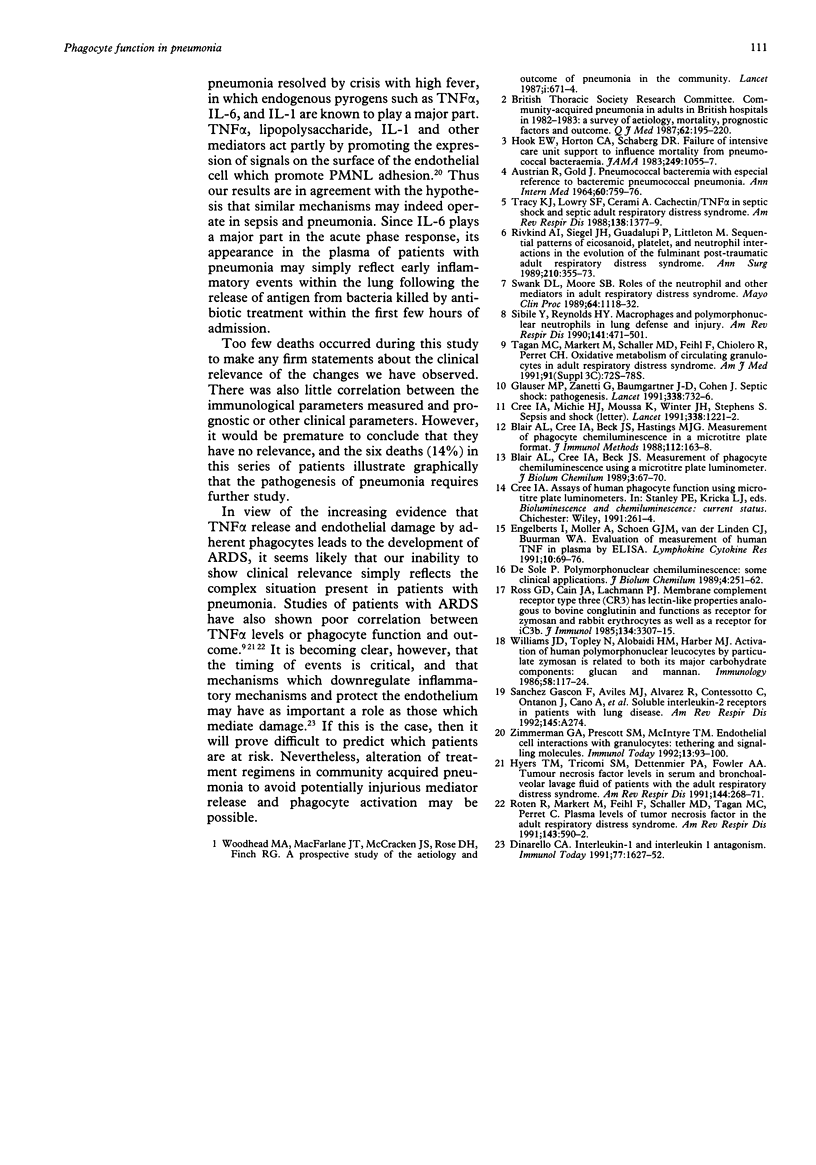Abstract
BACKGROUND--It is possible that many deaths from pneumonia may involve the generation of inflammatory mediators and tissue damage by activated phagocytes. To test this hypothesis phagocyte function, plasma levels of interleukin 6 (IL-6), tumour necrosis factor alpha (TNF alpha), and soluble interleukin 2 receptor (IL-2R), disease severity, and outcome have been examined in 46 patients with community acquired pneumonia. METHODS--Polymorphonuclear leucocyte (PMNL) and monocyte function were measured daily by chemiluminescence in these patients during the first week of admission, and cytokine levels were subsequently determined by ELISA. A series of 61 healthy individuals were used as a control group for the chemiluminescence results. RESULTS--There was evidence of phagocyte, particularly PMNL, activation on admission in 76% of the patients. Most patients (86%) also had raised IL-2R levels on admission. IL-6 and unbound TNF alpha were present in 23% and 41% of patients at varying times during the course of the disease. There was little correlation between measurements of cytokine or phagocyte levels and outcome or indicators of disease severity, although this may be because of the small number of patients included in this preliminary study. CONCLUSIONS--These results are consistent with the hypothesis that activated phagocyte function and raised levels of circulating cytokines may contribute to the pathogenesis of community acquired pneumonia. There are striking similarities in this respect between pneumonia, adult respiratory distress syndrome, and sepsis.
Full text
PDF




Selected References
These references are in PubMed. This may not be the complete list of references from this article.
- AUSTRIAN R., GOLD J. PNEUMOCOCCAL BACTEREMIA WITH ESPECIAL REFERENCE TO BACTEREMIC PNEUMOCOCCAL PNEUMONIA. Ann Intern Med. 1964 May;60:759–776. doi: 10.7326/0003-4819-60-5-759. [DOI] [PubMed] [Google Scholar]
- Blair A. L., Cree I. A., Beck J. S., Hastings M. J. Measurement of phagocyte chemiluminescence in a microtitre plate format. J Immunol Methods. 1988 Sep 13;112(2):163–168. doi: 10.1016/0022-1759(88)90352-3. [DOI] [PubMed] [Google Scholar]
- Blair A. L., Cree I. A., Beck J. S. Measurement of phagocyte chemiluminescence using a microtitre plate luminometer. J Biolumin Chemilumin. 1989 Apr-Jun;3(2):67–70. doi: 10.1002/bio.1170030206. [DOI] [PubMed] [Google Scholar]
- De Sole P. Polymorphonuclear chemiluminescence: some clinical applications. J Biolumin Chemilumin. 1989 Jul;4(1):251–262. doi: 10.1002/bio.1170040136. [DOI] [PubMed] [Google Scholar]
- Dinarello C. A. Interleukin-1 and interleukin-1 antagonism. Blood. 1991 Apr 15;77(8):1627–1652. [PubMed] [Google Scholar]
- Engelberts I., Möller A., Schoen G. J., van der Linden C. J., Buurman W. A. Evaluation of measurement of human TNF in plasma by ELISA. Lymphokine Cytokine Res. 1991 Apr;10(1-2):69–76. [PubMed] [Google Scholar]
- Glauser M. P., Zanetti G., Baumgartner J. D., Cohen J. Septic shock: pathogenesis. Lancet. 1991 Sep 21;338(8769):732–736. doi: 10.1016/0140-6736(91)91452-z. [DOI] [PubMed] [Google Scholar]
- Hook E. W., 3rd, Horton C. A., Schaberg D. R. Failure of intensive care unit support to influence mortality from pneumococcal bacteremia. JAMA. 1983 Feb 25;249(8):1055–1057. [PubMed] [Google Scholar]
- Hyers T. M., Tricomi S. M., Dettenmeier P. A., Fowler A. A. Tumor necrosis factor levels in serum and bronchoalveolar lavage fluid of patients with the adult respiratory distress syndrome. Am Rev Respir Dis. 1991 Aug;144(2):268–271. doi: 10.1164/ajrccm/144.2.268. [DOI] [PubMed] [Google Scholar]
- Rivkind A. I., Siegel J. H., Guadalupi P., Littleton M. Sequential patterns of eicosanoid, platelet, and neutrophil interactions in the evolution of the fulminant post-traumatic adult respiratory distress syndrome. Ann Surg. 1989 Sep;210(3):355–373. doi: 10.1097/00000658-198909000-00012. [DOI] [PMC free article] [PubMed] [Google Scholar]
- Ross G. D., Cain J. A., Lachmann P. J. Membrane complement receptor type three (CR3) has lectin-like properties analogous to bovine conglutinin as functions as a receptor for zymosan and rabbit erythrocytes as well as a receptor for iC3b. J Immunol. 1985 May;134(5):3307–3315. [PubMed] [Google Scholar]
- Roten R., Markert M., Feihl F., Schaller M. D., Tagan M. C., Perret C. Plasma levels of tumor necrosis factor in the adult respiratory distress syndrome. Am Rev Respir Dis. 1991 Mar;143(3):590–592. doi: 10.1164/ajrccm/143.3.590. [DOI] [PubMed] [Google Scholar]
- Sibille Y., Reynolds H. Y. Macrophages and polymorphonuclear neutrophils in lung defense and injury. Am Rev Respir Dis. 1990 Feb;141(2):471–501. doi: 10.1164/ajrccm/141.2.471. [DOI] [PubMed] [Google Scholar]
- Swank D. W., Moore S. B. Roles of the neutrophil and other mediators in adult respiratory distress syndrome. Mayo Clin Proc. 1989 Sep;64(9):1118–1132. doi: 10.1016/s0025-6196(12)64981-7. [DOI] [PubMed] [Google Scholar]
- Tagan M. C., Markert M., Schaller M. D., Feihl F., Chiolero R., Perret C. H. Oxidative metabolism of circulating granulocytes in adult respiratory distress syndrome. Am J Med. 1991 Sep 30;91(3C):72S–78S. doi: 10.1016/0002-9343(91)90287-8. [DOI] [PubMed] [Google Scholar]
- Tracey K. J., Lowry S. F., Cerami A. Cachetin/TNF-alpha in septic shock and septic adult respiratory distress syndrome. Am Rev Respir Dis. 1988 Dec;138(6):1377–1379. doi: 10.1164/ajrccm/138.6.1377. [DOI] [PubMed] [Google Scholar]
- Williams J. D., Topley N., Alobaidi H. M., Harber M. J. Activation of human polymorphonuclear leucocytes by particulate zymosan is related to both its major carbohydrate components: glucan and mannan. Immunology. 1986 May;58(1):117–124. [PMC free article] [PubMed] [Google Scholar]
- Woodhead M. A., Macfarlane J. T., McCracken J. S., Rose D. H., Finch R. G. Prospective study of the aetiology and outcome of pneumonia in the community. Lancet. 1987 Mar 21;1(8534):671–674. doi: 10.1016/s0140-6736(87)90430-2. [DOI] [PubMed] [Google Scholar]
- Zimmerman G. A., Prescott S. M., McIntyre T. M. Endothelial cell interactions with granulocytes: tethering and signaling molecules. Immunol Today. 1992 Mar;13(3):93–100. doi: 10.1016/0167-5699(92)90149-2. [DOI] [PubMed] [Google Scholar]


